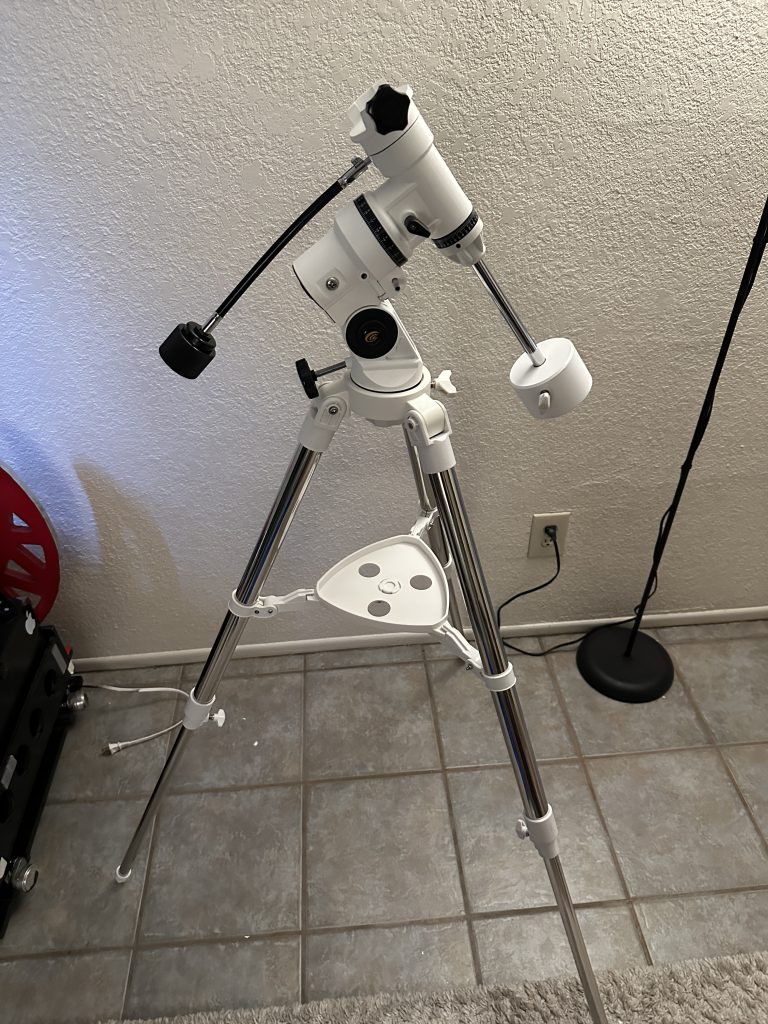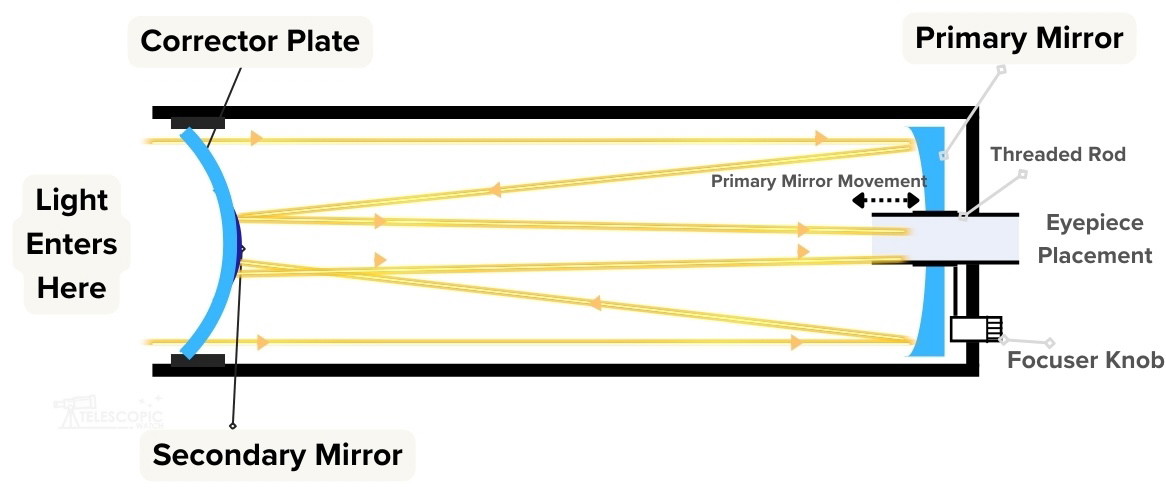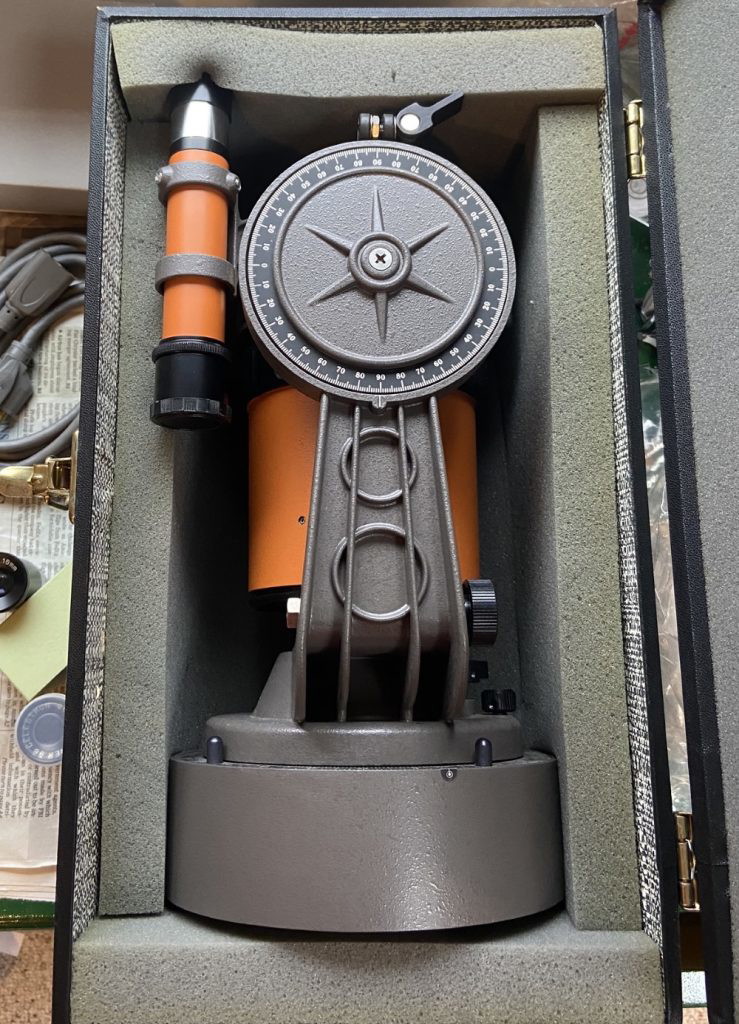C90 as a Spotting Scope:
Celestron today markets the C90 as mainly a spotting scope, unlike the case with the Classic C90s that was discontinued in the late 1990’s.
I judge today’s Celestron C90 as an excellent spotting scope thanks to its compactness and its close focus range.
With the C90, I could even focus on objects as close as 15 feet! This makes it very ideal for some sports like target shooting or even hunting, where usually 100–200 yards of distance are being used. None of the refractors I know of can do this without adding extension tubes or having a very long focuser, both of which can vignette the light cone and the views.
C90 as an Astronomical Scope:
Because of the inclusion of Vixen dovetail bar in the Celestron C90, I can easily put it on any astronomical mount that has a Vixen dovetail saddle. I believe an EQ-3 class equatorial mount or something like the Explore Scientific Twilight I or Vixen Porta II would be optimal to be used with the Celestron C90. I see the tripod included with the C90 as being too small to be of any use, but still not terrible for the price.

If I were you, I’d also swap the correct-image diagonal for a 90-degree star diagonal before getting straight to astronomical observation. The included 45-degree diagonal is awkward for astronomy, but still for the price, it’s not a huge deal.
I find the viewfinder of the C90 very easy to align and it also doesn’t move once it’s aligned.
I’ve tested the included 32mm Plossl eyepiece and found it to be good for low power. But you’ll want additional shorter-focal-length eyepieces for higher magnification views, which is what a small Maksutov like the C90 excels at. I can practically take up to 200x magnification with this small wonder if viewing conditions permit me to.
I think the C90 has only two main limitations when it comes to astronomical use:
- It’s small at just 90 mm of aperture (light-gathering capability). So, we’re limited to the Moon, planets, and only the brightest deep-sky objects.
- The long focal length of the C90 makes the above point more of a problem. The 1250mm focal length implies a lower field of view with any given eyepiece. As the brightest deep-sky objects almost always tend to be big (the Pleiades, for example), you can’t even fit them fully in your field of view.
The C90’s baffle tube is shiny, which leads to glare and other contrast-reducing reflections (baffle tubes aren’t supposed to be shiny). To solve it, what I do is buy some adhesive flocking paper or black velvet and insert it into the baffle tube. It’s annoying that one has to do this, but I can overlook this since it’s only a minor expense.
C90 for Astrophotography:
The C90’s visual back (which holds the diagonal) is T-threaded, so you can put your DSLR on the back with the help of a T-ring ($10 or so). But I’d warn you to tone down your expectations, as the results will never be as good as the Schimdt-Cassegrain (SCT) type of telescope.
Also, the long focal ratio of nearly f/14 makes the scope useless for long exposure astrophotography of deep-sky-objects, so you’re limited to quick snaps of the Moon and planets.
The Majestic History
The C90 is a Maksutov-Cassegrain, an optical design invented by a young Soviet engineer named Dmitry Dmitrievich Maksutov. Maksutov sought to invent a compact, easy-to-manufacture telescope suitable for use in schools and the military.
The Maksutov-Cassegrain uses a very fast spherical primary mirror with a corrector lens at the front. If this sounds familiar, it’s because the Schmidt-Cassegrain works in exactly the same manner. The difference is the shape of the corrector.

While a Schmidt uses a nearly flat fourth-order curve on a thin piece of glass, the Maksutov corrector is a highly curved, thick meniscus lens. This makes it far easier to manufacture with conventional optical facilities (a Schmidt requires special tools unique to it) and also far more shatterproof.
The thickness of the corrector makes it difficult and expensive to construct a good large Maksutov. The cost skyrockets at large apertures and the large, thick mass at the front of the tube causes thermal problems. I regularly use one of the largest Maksutovs in the world and it has severe thermal issues, mainly due to the thickness of the corrector.
The original Mak-Cass used a separate secondary mirror attached to the corrector, just like a Schmidt-Cassegrain.
However, the American optical designer John Gregory realized that with some slight modifications, the secondary could be nothing more than an aluminized spot on the back of the corrector. This allows for minimal collimation, if any is needed at all, and furthermore, makes the telescope far easier to seal airtight. Gregory’s idea was genius and within a few years, the Questar Corporation began marketing 3.5”, 7”, and 12” Gregory-Maksutovs.
The Questar 3.5 is a beautiful instrument, but it is extraordinarily expensive. Until the late 1970s, it was the only choice if you wanted an extremely portable telescope with no collimation required and without inconveniences such as an open tube. Enter the original, orange C90.
With no significant difference specs-wise, besides a slightly shorter focal length (1000mm for the original C90 vs. 1250mm for the Questar and modern C90) and going for a fraction of the price of the Questar, many who couldn’t afford the Questar flocked to the C90 as an answer.

However, the original C90 had a couple of problems. The main one was its focusing system. The original C90’s focusing mechanism is basically like a telephoto lens. The entire upper section of the tube twists. This works fine when the C90 is on the rather rare Celestron-made fork mount, but on a more standard mount or a simple photo tripod, it can lead to vibrations, making it hard to focus and use at high magnification.
The orange C90 faded away in the 1980s, though you could still buy a black-tubed, later rubber-armored version (usually with mediocre to poor optics) through the late 1990s. Then the C90 completely disappeared.
In the mid-2000s, Celestron remade and re-released the C90 in the form available today.
With a 1250mm focal length, conventional focusing system (the primary mirror slides back and forth on a rod), and better quality control, the modern C90 more or less duplicates the Questar at around 1/20th of the price! Also, its modern multi-coatings make images quite a bit brighter than in the original C90.


Great review! Very informative and helpful. I’m glad you included the flocking tip as that is really the only significant “flaw” of this particular scopes implementation. Synta Corp. would do well to correct this for just a few extra dollars in cost passed to the consumer instead of leaving it up to the purchaser, but it’s not enough of a sticking point to really matter and a simple enough fix for most DIY’ers. Thanks for bringing “light” to this spottingscope as a very capable and extremely affordable astronomical instrument.
I also think this review is great. Just a comment or two. Older C90s did not use 1 1/4 eyepieces; one had to use an adaptor for those. I owned one of the orange version scopes when it came out years ago, and also a later black version of that design, both with the old focusing system. They worked OK for spotting scope applications, but the new version is much better at both light gathering (and use of easy-to-get 1 1/4 lenses and accessories) and the focus system is so much better, especially for astronomy. Finally, the included 32mm Plössl eyepiece is a terrific performer…I prefer it to a more expensive one that I own, used on another scope. Simply put, as the reviewer suggests, the current C90 performs exceeding well for what it’s designed to do, and is a super value at that. Great portable scope!
I recently purchased the C90 and found nothing wrong with it it’s a excellent spotting scope for the price I bought mine on Amazon I have taken excellent photos of the moon with a Canon DSLR Camera the T ring adapter is very handy to have I would highly recommend anyone to buy this Scope.
I used to like fiddling with my C90, using it outdoors etc., as well as for astronomy, changing out diagonals, doing the flocking thing, and so on. And Maks have a certain fascination. But in the past few days the moon has been well placed, and frankly the C90 is blown away by my Astrotech 72 mm ED refractor (the old version), even if I have to use very short FL eyepieces with the refractor to make a proper comparison. So I’m not sure if it has a place in my “collection” any more.
I’ve owned a number of C90s over the years from the orange tubes to the black armored series, nothing more than the orange tube with a black rubber coating. They came with .965 eyepieces in their day and you had to buy a hybrid adapter to get a 1 1/4″ eyepiece to fit. I ran through the gambit and decided, in spite of my MAks, classic casses, refractors and reflectors, all EQ scopes, to add the newer version of the C90. Do I need it..NO. Was it a steal…well, at $50 NIB but a desperate in need of a few buck…yea! I can sell the cheap tripod for $30 on the market and have this for practically nothing. I have a spare Orion EQ-1 motorized mount that is vacant just waiting for this as well as numerous other EQs and AltAz that will work wonders for spotting . I will probably also sell the 8x21mm finder and put a 6×30 or larger on it…perhaps overkill but what the heck, eh? I know nothing of flocking the tube. Can someone explain to me what needs to be flocked. Easy enough to do….Is it the inside of the focusing tube rather than the main tube? I don’t like to take MAKs apart. The focus tube is fine if that’s what it is. I have a 90mm dielectric 90 I’ll put on this as well. So a cheap but from reviews, generally quality grab and go scope or a moneymaker for me if I chose to part with it….Thanks for any info you can give me on the flocking thing. Thanks!
Bonjour,
J’ai acquis récemment un C90 Mak et en suis fort satisfait, car cela m’évite de déplacer régulièrement du matériel astronomique plus lourd sur monture équatoriale… Donc, ce C90 se met vite en station sur une monture azimutale et permet bien des observations… dans la limite de ses possibilités optiques. Comme j’ai un oculaire Vixen à amplification variable, c,est l’idéal, vraiment ! Mais, comme d’autres avant moi, je ne comprends pas du tout comment il faut faire pour éviter l’éblouissement dont vous parlez, du fait de reflets… Si quelqu’un a déjà fait cette transformation, peut-il nous indiquer en détails comment faire cela ? Merci par avance !! Amitiés du Québec !
Installez simplement du papier flocage à l’intérieur du tube de chicane principal. Voici quelques guides: https://www.youtube.com/watch?v=FPFZbqbjbP0 https://www.cloudynights.com/topic/603153-new-c90-owner-contrastflocking-mod/
Awesome review.
There are indeed a lot of replacements that needed to be done for astronomy use. However, I would like to know which are the suitable choices for it. Please give me some hints about:
1. A new tripod (below 100 $)
2. A new finderscope.
And a new 90° diagonal.
3. Higher power eyepiece (below 13mm).
1. The best photo tripod you can get… not a lot of options
2. Rigel Quikfinder or a generic red dot finder
Included diagonal is fine, no need to replace it
9mm or 6mm goldline for high power